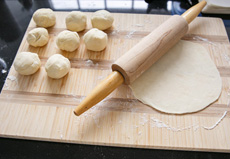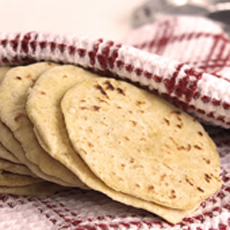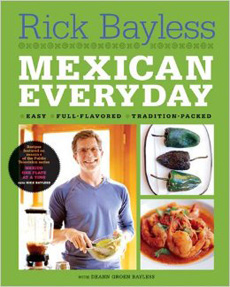TIP OF THE DAY: Make Your Own Corn Tortillas
|
Do something different for Cinco de Mayo: Make your own corn tortillas.
Americans eat lots of tortillas: Back in 2000, the Tortilla Industry Association estimated that Americans consumed approximately 85 billion tortillas (not including tortilla chips). They haven’t updated their website information, but we can safely assume that tortilla sales have only gone up. [Source] Yet the majority of us have never have seen handmade tortillas. Most Mexican restaurants and retailers have machine-made tortillas, pressed very flat with added preservatives to extend their shelf life. Tortillas are a flatbread (see the different types of bread). In a tortilleria (tortilla bakery) or Mexican restaurant, masa (cornmeal dough) is rolled into small balls of dough, flattened and cooked them quickly on a hot skillet. They require only one ingredient—masa harina, a special cornmeal—plus water. Like fresh-baked loaves of bread, fresh-baked tortillas are heavenly—and much faster to make. They have no fat or preservatives, so must be eaten the day they’re made (or stored in the fridge for 2-3 days). If you don’t have a local tortilleria, it’s easy to make your own. The recipe is below. > Also below, the different forms of ground corn (cornmeal, hominy, masa, etc.). Corn tortillas vs. flour tortillas.> Before wild yeast was harnessed by man, bread meant flatbread the world over: arepa, bánh, bannock, focaccia, injera, johnnycake, lavash, matzoh, naan, piadina, pita, pizza, puri, roti, tortilla and dozens of others. Tortillerias are native to Mexico and Central America, where they remain a staple food. The oldest tortillas discovered by archaeologists date back to around 10,000 B.C.E., made of maize (maize—corn—is native to Central America). The dried corn kernels were ground into cornmeal, which was mixed with water to make a dough called masa. When Hernán Cortés and his conquistadors arrived in what is today Mexico (on April 22, 1519), they encountered the native women making tortillas—flat corn bread. In the Aztec language Nahuatl, it was called tlaxcalli (teu-ax-CAH-lee). The Spanish called them tortillas, little cakes. Originally hand-flattened, “technology” most likely evolved to flattening with an implement, and later to manually operated wooden tortilla presses, flattening the tortilla dough one by one. Modern machinery can produce up to 60,000 tortillas an hour. Tortillas are now wheat flour in addition to maize. Typically, corn tortillas are used for tacos, flour tortillas for burritos. |
|
|
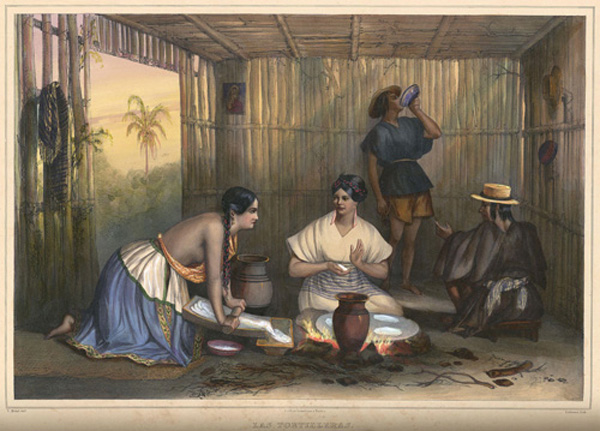 Mexican women making grits in a work by Carl Nebel, 1836. THE DIFFERENT FORMS OF GROUND CORN Unless you work with these products regularly, you can’t be expected to know that all arground cornmeal, dried corn that’s ground down into smaller, coarse bits. All you need to make tortillas is masa harina and water. Masa harina, Spanish for dough flour, is the corn flour (corn meal) used to make tortillas and tamales. You can’t substitute regular cornmeal: Masa harina is specially treated corn (see the next section). You can find masa harina in any Latin American market or another market with a good Latin American foods section. We prefer Bob’s Red Mill brand, which we pick up at Whole Foods. Rick Bayless uses Maseca brand. Since the cornmeal provides the only flavor in the tortilla, go for the freshest, best quality product. And don’t buy “instant.” *If you’re near a tortilleria, you may be able to purchase fresh, smooth-ground corn masa. On the other hand, if you’re at a tortilleria, you can purchase the tortillas freshly baked. |
||
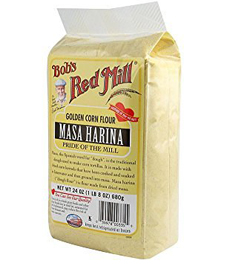 [4] All you need to make tortillas: masa harina and water. Because the corn flour is the only flavor to the tortilla, buy the best (photo © Bob’s Red Mill).
|
Preparation 1. MEASURE the masa harina into a bowl and add 1 cup plus 2 tablespoons of hot tap water. Knead with your hands until thoroughly combined. Cover and let stand 15 minutes. (If using fresh-ground masa, available from a tortilleria, scoop it into a bowl, break it up and knead a few times until smooth.) 2. SET a large griddle (one that stretches over 2 burners) or 2 skillets on your stovetop. Heat one end of the griddle (or one skillet) to medium, the other end (or another skillet) to medium-high. 3. SQUEEZE the dough gently. If it is stiff (it probably will be), knead in some water, 1 or 2 teaspoons at a time, until the dough feels like soft cookie dough: not stiff, but not sticky. Divide the dough into 15 pieces, rolling each into a ball. Cover with plastic. 4. CUT 2 squares of a plastic bag, 1 inch larger than your tortilla press (we used our George Forman grill with the flat plates). Open the press and lay it on one piece of plastic. Lay a dough ball in the center, and gently mash it. Top with the second piece of plastic and close press. Gently flatten the dough into a 1/8-inch-thick disk. Peel off the top piece of plastic. 5. FLIP the tortilla onto your right hand (if you’re right-handed); the top of the tortilla should line up with the side of your index finger. Gently roll it onto the side of the griddle (or skillet) heated to medium. Let the bottom of the tortilla touch the griddle, then lower your hand slightly and move it away from you. The tortilla will stick to the hot surface so you can roll your hand out from under it as it rolls down flat. After 30 seconds, the edges of the tortilla will dry slightly and the tortilla will release from the griddle. Until this moment, the tortilla will be stuck. 6. FLIP the tortilla onto the hotter side of the griddle (or the hotter skillet) with a metal spatula. After 30 seconds, the tortilla should be lightly browned underneath. Flip it over. Cook 30 seconds more—the tortilla should puff in places (or all over—a gentle press with a metal spatula or fingers encourages puffing). Transfer to a basket lined with a napkin or towel. 7. PRESS and bake the remaining tortillas. Stack each newly baked tortilla on top of the previously baked tortillas. Keep the tortillas well wrapped in a kitchen towel for warmth. |
|
|
REHEATING CORN TORTILLAS Some people have a tortilla steamer to reheat tortillas in the microwave (we picked up a silicone steamer and use it every day to warm or steam other foods in our microwave). But you don’t need one: You can substitute a kitchen towel. People who don’t enjoy the more pronounced flavor or texture of corn tortillas prefer the milder, softer flour tortillas are prized for their mild flavor and softness. Either can be used in any recipe requiring tortillas. However: CHECK OUT WHAT’S HAPPENING ON OUR HOME PAGE, THENIBBLE.COM. |
||
